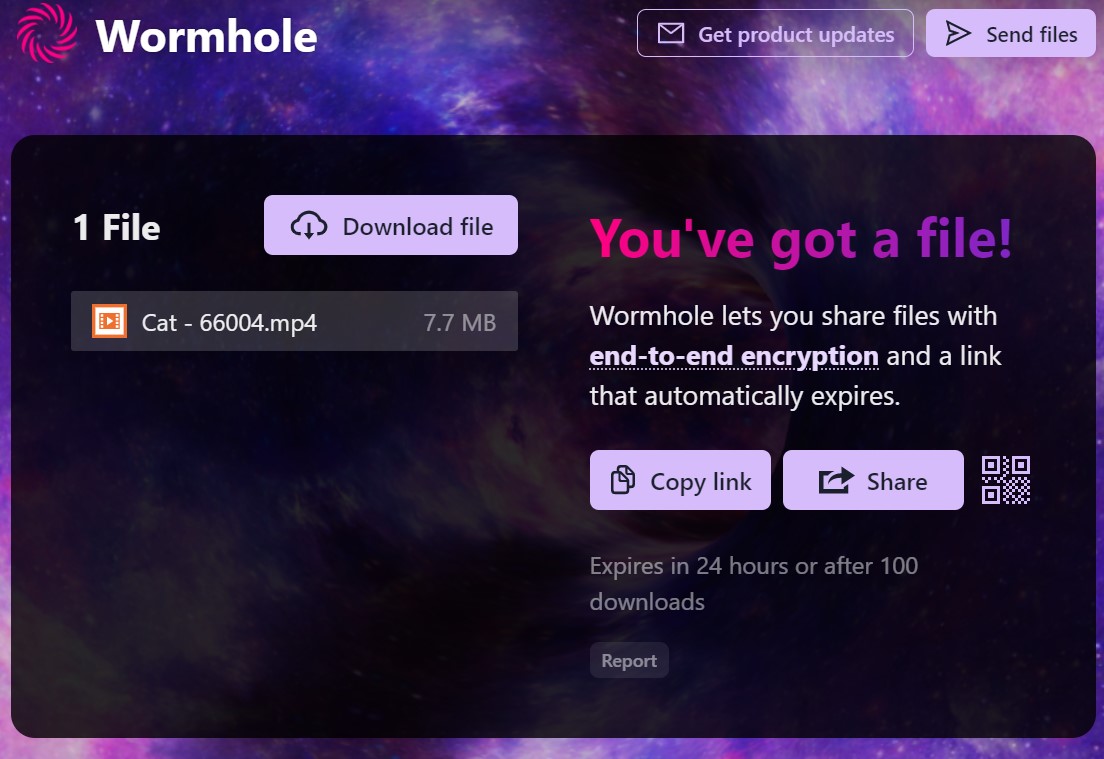 Most people still associate torrents with desktop clients. However, the browser-native WebTorrent equivalent has become the driving force behind many innovative services.
Most people still associate torrents with desktop clients. However, the browser-native WebTorrent equivalent has become the driving force behind many innovative services.
Simply put, WebTorrent has built a bridge between BitTorrent with the web. Instead of using standalone applications, it allows people to share files directly from their browser, without having to configure or install anything.
In recent years there have been a few services built on this technology. βTorrent is a full-fledged torrent client that works in the browser, and File.pizza was one of the first to develop a simple one-click file-sharing tool.
The new “Wormhole” service also offers free and simple file-sharing, but it goes a step further. Wormhole adds a privacy layer by offering end-to-end encrypted file transfers. And while it uses WebTorrent under the hood, users don’t have to keep seeding.
One of the driving forces behind the project is none other than Feross Aboukhadijeh, who also invented WebTorrent. Together with John Hiesey, he launched Wormhole to allow people to securely send small and large files in a matter of seconds. No signup required.
Fast and Secure
The strong emphasis on speed and security sets the service apart from many competitors. By using end-to-end encryption, only the sender and the receiver can see the files. This is not the case with Dropbox, WeTransfer, and other sharing platforms.
“We built Wormhole with end-to-end encryption. When you use Wormhole, a key is generated on your device and used to encrypt your files. In transit, your data is unreadable to Wormhole and service providers like your ISP,” Wormhole explains.
The focus on speed is where WebTorrent comes in. Wormhole uses a combination of cloud hosting servers and BitTorrent technology to be able to share large files as fast as possible. If you upload a two-gigabyte video, you can share the link with other people instantly, even when you’re not done uploading yet.
Instant Downloading
Wormhole co-founder Feross tells us that this allows recipients to download files right away – before the file is fully hosted on Wormhole’s servers. Inline media viewing for images and videos is on the roadmap as well.
“Because we’re using WebTorrent under the hood, Wormhole has the ability to do ‘instant streaming’ – so there’s no need to wait for your files to upload before you send the share link to your recipient,” Feross explains.
“You can see it in action when you send a super large file through Wormhole. If you send the share link to the recipient before your files have finished uploading, then WebTorrent will simultaneously start streaming the file directly to the recipient.”

P2P technology can significantly speed up file transfers. This is particularly true when people are in the same network. If that’s the case, the files don’t even have to travel over the Internet. Needless to say, this advantage disappears when the browser tab is closed.
Limitations
While we are certainly impressed by the ease of use, Wormhole has its limitations. When people upload files larger than five gigabytes they have to keep their browser windows open. These files will not be stored on Wormhole’s servers. For smaller files, the browser tab can be closed after uploading.
There are a few other restrictions as well. The uploaded files are only available for 24 hours after which they are deleted from the server. In addition, there’s a limit of 100 downloads for every file.
Feross tells us that Wormhole is primarily designed for people who want to share files quickly and securely with other individuals or a small group. It’s not intended to store files permanently or send something to millions of people.
Expansion
Wormhole has only been live for a few weeks and it’s still in development. To pay the bills, the team plans to release a premium version with larger file sending limits, and other features including customizable link expiration times.
Looking even further ahead, Feross and John are considering the addition of a business plan. This may be particularly useful for lawyers, accountants, doctors, and other professionals, who have to securely send documents and other files.
“These industries are currently unable to use mainstream cloud storage providers due to privacy concerns and so they are stuck using slow, clunky file management apps which leave a lot to be desired,” Feross says.
Eventually, the project could even expand to other apps for businesses and consumers, by offering dedicated tools to securely manage and share photos, documents, and spreadsheets. These will also have a strong focus on end-to-end encryption.
“Today, every major website is designed so that the service provider possesses the key to your data. We think this is unacceptable and there’s a better way, Feross adds.
Perhaps the service is best explained by simply giving it a try. There’s no need to register an account and the service isn’t just secure, but also free to use.
From: TF, for the latest news on copyright battles, piracy and more.
0 Commentaires